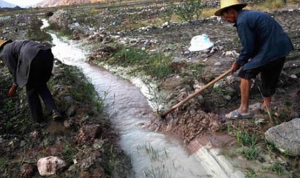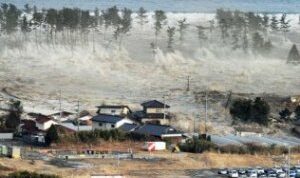 Record-shattering temperatures this summer have scorched countries from Morocco to Saudi Arabia and beyond, as climate experts warn that the severe weather could be a harbinger of worse to come.
Record-shattering temperatures this summer have scorched countries from Morocco to Saudi Arabia and beyond, as climate experts warn that the severe weather could be a harbinger of worse to come.
UN officials and climate scientists predict that, in coming decades, the region’s mushrooming populations will face extreme water scarcity, temperatures almost too hot for human survival and other consequences of global warming.
If that happens, more conflicts and refugee crises – far greater than those currently under way – are likely, Adel Abdellatif, a senior adviser at the UN Development Program’s Regional Bureau for Arab States, said.
“This incredible weather shows that climate change is already taking a toll now and that it is – by far – one of the biggest challenges ever faced by this region,” said Mr Abdellatif, who works on studies about the impact of climate change on the region.
These countries have already been grappling with remarkably warmer summers in recent years, but this year has been particularly brutal.
Parts of the United Arab Emirates and Iran experienced a heat index – a measurement that factors in humidity – that soared to 60 degrees in July, and Jiddah, Saudi Arabia, had an all-time high of nearly 52 degrees. Southern Morocco’s relatively cooler climate suddenly sizzled last month with temperatures surging between 43 and 47 degrees. In May, record-breaking temperatures in Israel caused brush fires and a surge of heat-related illnesses.
But the temperatures in Kuwait and Iraq startled observers. On July 22, the mercury climbed to 54 degrees in the southern Iraqi city of Basra. A day earlier, it reached 54 in Mitribah, Kuwait. If confirmed by the World Meteorological Organisation, the two would mark the hottest temperatures ever recorded in the eastern hemisphere.
The bad news isn’t over, either. Iraq’s heat wave is expected to continue this week.
Stepping outside is like “walking into a fire”, said Zainab Guman, a 26-year-old university student who lives in Basra.
“It’s like everything on your body – your skin, your eyes, your nose – starts to burn,” she said.
Guman has rarely left home during daylight hours since June, when temperatures started rising above 49 degrees and metal objects outside turned into searing-hot hazards.
About that time, Aymen Karim also began feeling trapped.
The 28-year-old engineer at a government-run oil company in Basra said employees were ordered to stay at home for several days over the past month. He and his family try not to go outside before 7pm.
“We’re prisoners,” Karim said.
Bassem Antoine, an Iraqi economist, said the weather has inflicted serious damage to the country’s economy. He estimates that Iraq’s output – about $US230 billion ($US298 billion) annually – has probably contracted between 10 and 20 per cent during the summer heat.
Iraqi officials say scores of farmers around the country have been struggling with wilting crops, and general workforce productivity has decreased.
And hospitals have seen an uptick in the number of people suffering from dehydration and heat exhaustion.
Tens of thousands of Iraqis displaced by battles between government forces and Islamic State militants have endured the heat in tents and other makeshift shelters. Humanitarian organisations have been unable to reach all of them because of budget constraints, restrictions by Iraq’s government and risks associated with operating in war zones.
“A lot of these people are probably dying, but it’s hard to know,” said an official at an aid organisation who was not authorised to discuss the issue publicly, so spoke on the condition of anonymity.
In Baghdad, the temperature measured at its international airport has reached 43 degrees or higher nearly every day since June 19.
The government has declared multiple mandatory official holidays because of the heat. Even when that happens, many public employees have turned up to work anyway because of the constant airconditioning available at government offices.
Most Iraqi homes and businesses suffer daily power cuts for 12 hours or more. And most Iraqis – unlike their rich neighbours in Kuwait and Saudi Arabia – are too poor to afford 24-hour airconditioning anyway. Such a luxury requires paying expensive fees for gas-powered generators.
During daylight hours, Baghdad’s streets are empty, but some businesses remain open. It’s either sweat at work or starve at home, said Eissa Mohsen, who owns a fruit stand in the Karrada area of downtown Baghdad.
“Look over there. That’s an airconditioning unit, but I can’t afford to pay the generator fees to run it,” he said at his stall recently.
The immediate cause of all this is a stubborn high-pressure system, but a fundamental shift in the country’s weather patterns appears to be taking place, said Mahmoud Abdul-latif, spokesman of Iraq’s meteorological department. In Baghdad, he said, the number of days with temperatures at 48 degrees or higher have more than doubled in recent years.
“If you look back 40 years ago, you’d have these temperatures for four or five days, but then the wind would kick up dust and that would cool the surface. That’s just not happening now,” he said.
Climate scientists say this shouldn’t be surprising.
A study published by the journal Nature Climate Change in October predicted that heat waves in parts of the Persian Gulf could threaten human survival toward the end of the century.
Researchers at the Max Planck Institute for Chemistry and the Cyprus Institute in Nicosia recently predicted a similarly grim fate for the Middle East and North Africa, a vast area currently home to about half a billion people.
The region’s governments are generally not prepared to deal with rapidly growing populations and climactic shifts, Francesca de Chatel, an Amsterdam-based expert on Middle Eastern water issues, said. For years, they have failed to address these problems adequately despite warnings from climate experts and UN agencies, and it may be too late now, she said.
The UN predicts that 22 Arab countries’ population of about 400 million people would grow to nearly 600 million by 2050. That would place tremendous stress on countries where climate scientists predict significantly lower rainfall and saltier groundwater from rising sea levels. Already, most countries in the region face acute water crises because of dry climates, rapidly surging consumption and wasteful agricultural practices.
Analysts cite inadequate government handling of an unprecedented drought in Syria as a trigger for the country’s devastating civil war, which has produced extraordinary refugee flows that have spilled into Europe.
Last year, Iraqis rallied in Baghdad against their government’s inability to provide enough electricity during another scorching summer heat wave. Little, if anything, resulted from those demonstrations. According to some estimates, Iraq’s population of about 33 million will nearly double by 2050.
“The countries in the region are not prepared to cope with the effects of climate change,” de Chatel said.
Such a blistering future doesn’t seem like a far-off possibility to Arkan Farhan, 33, who lives with his family near Baghdad in a tin hut at a camp for people displaced by Islamic State.
Last month, he said, he contracted typhoid from a communal water source that has become particularly crowded – and filthy – this summer. To cool off, his sons use it to fill a pan for bathing.
Earlier this month, his 69-year-old father, Jassam, was rushed to the hospital after passing out from the heat.
“Fortunately, he was only bruised. He didn’t break any bones,” Farhan said of his father while sitting in his sweltering shack.
“Iraqis are strong people. But this heat is like a fire. Can people live in fire?”




